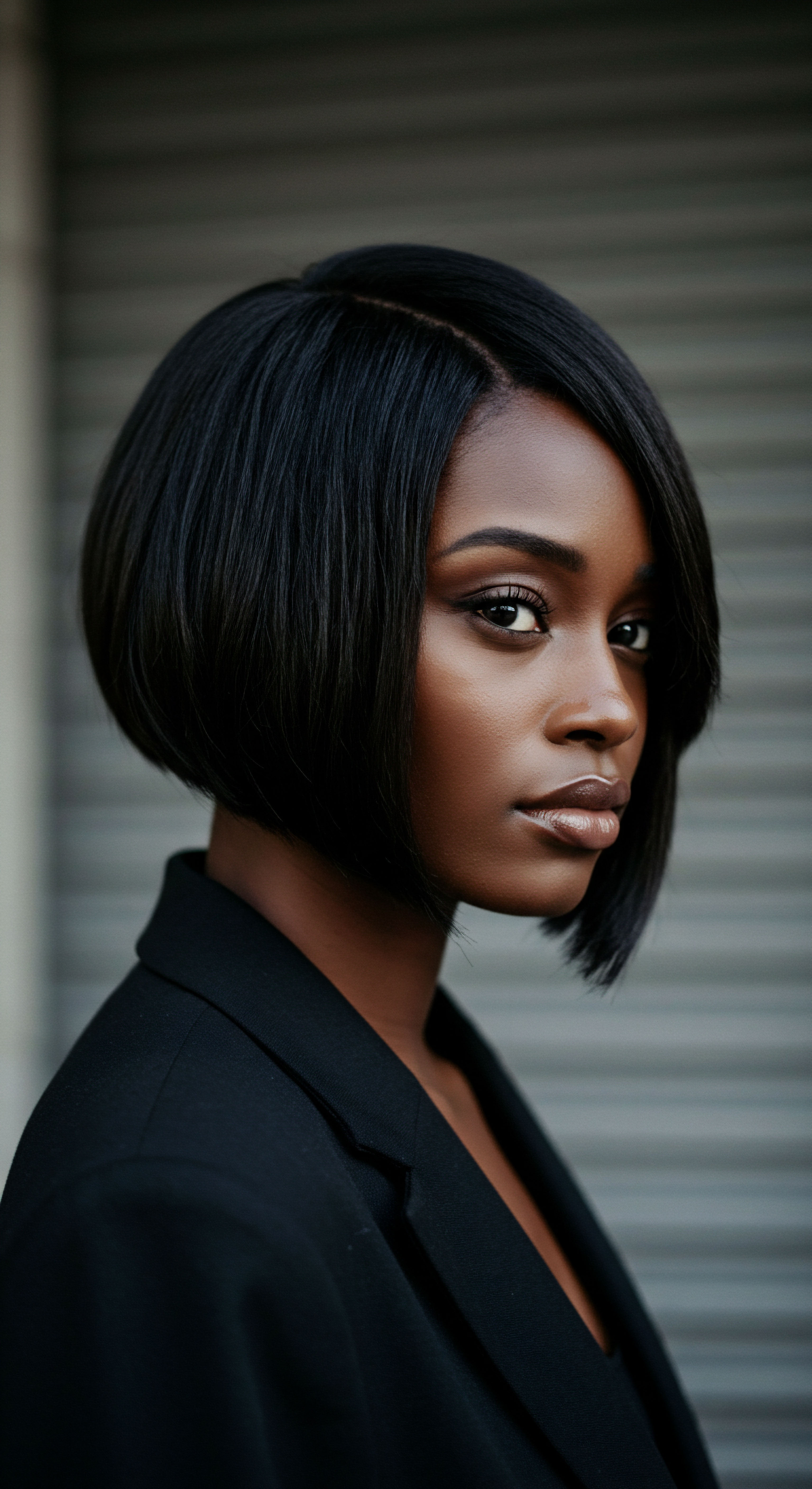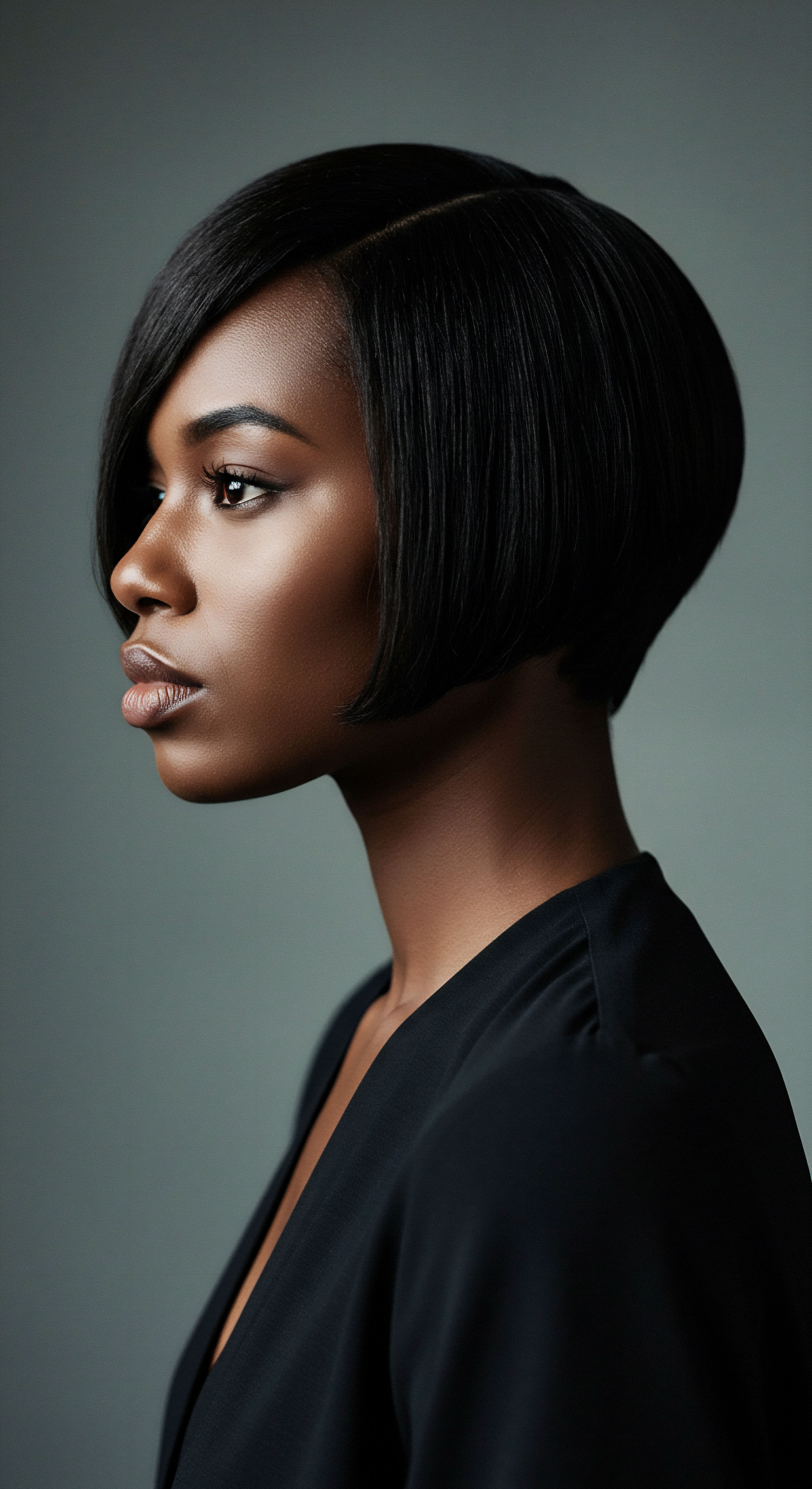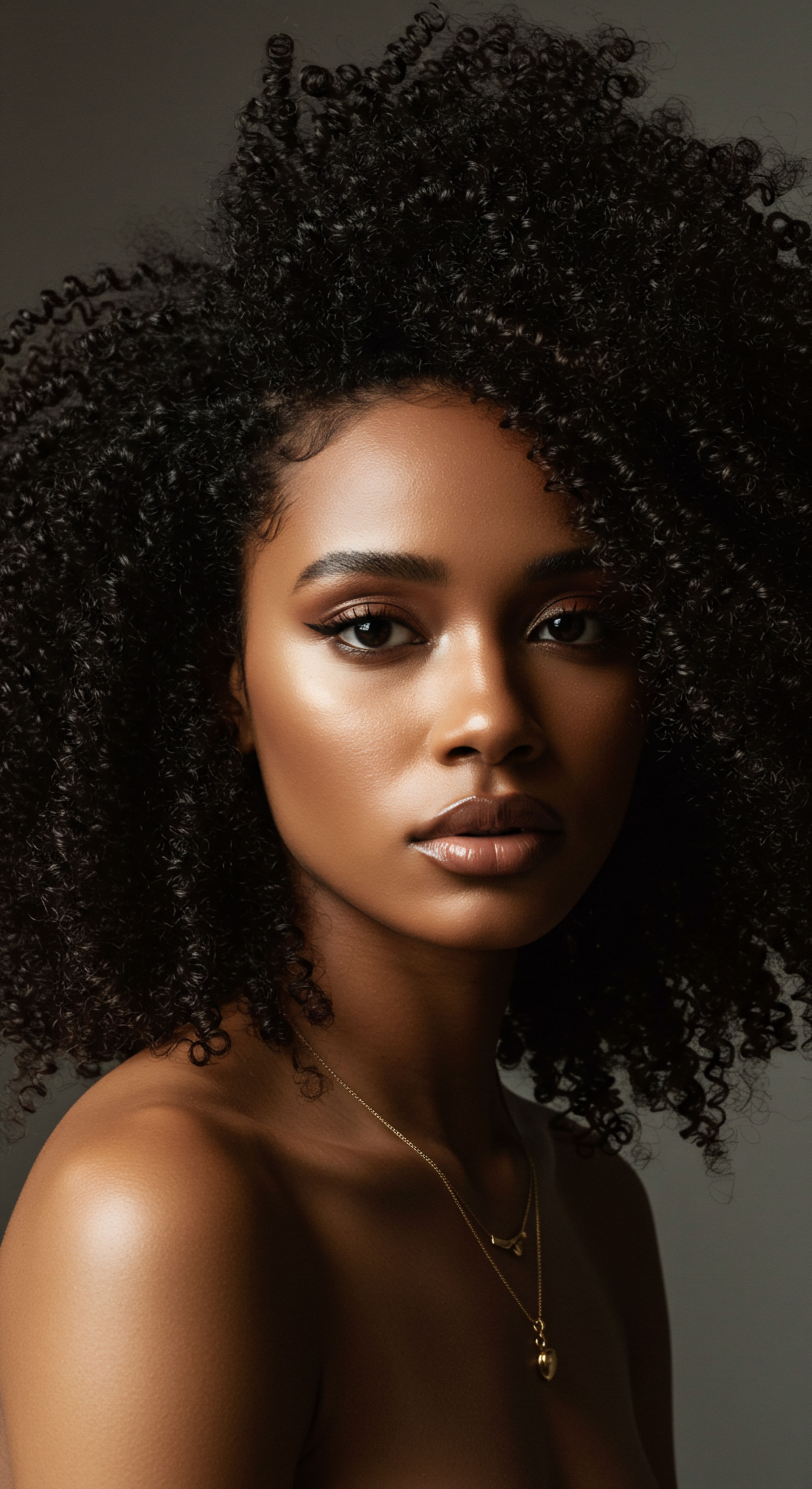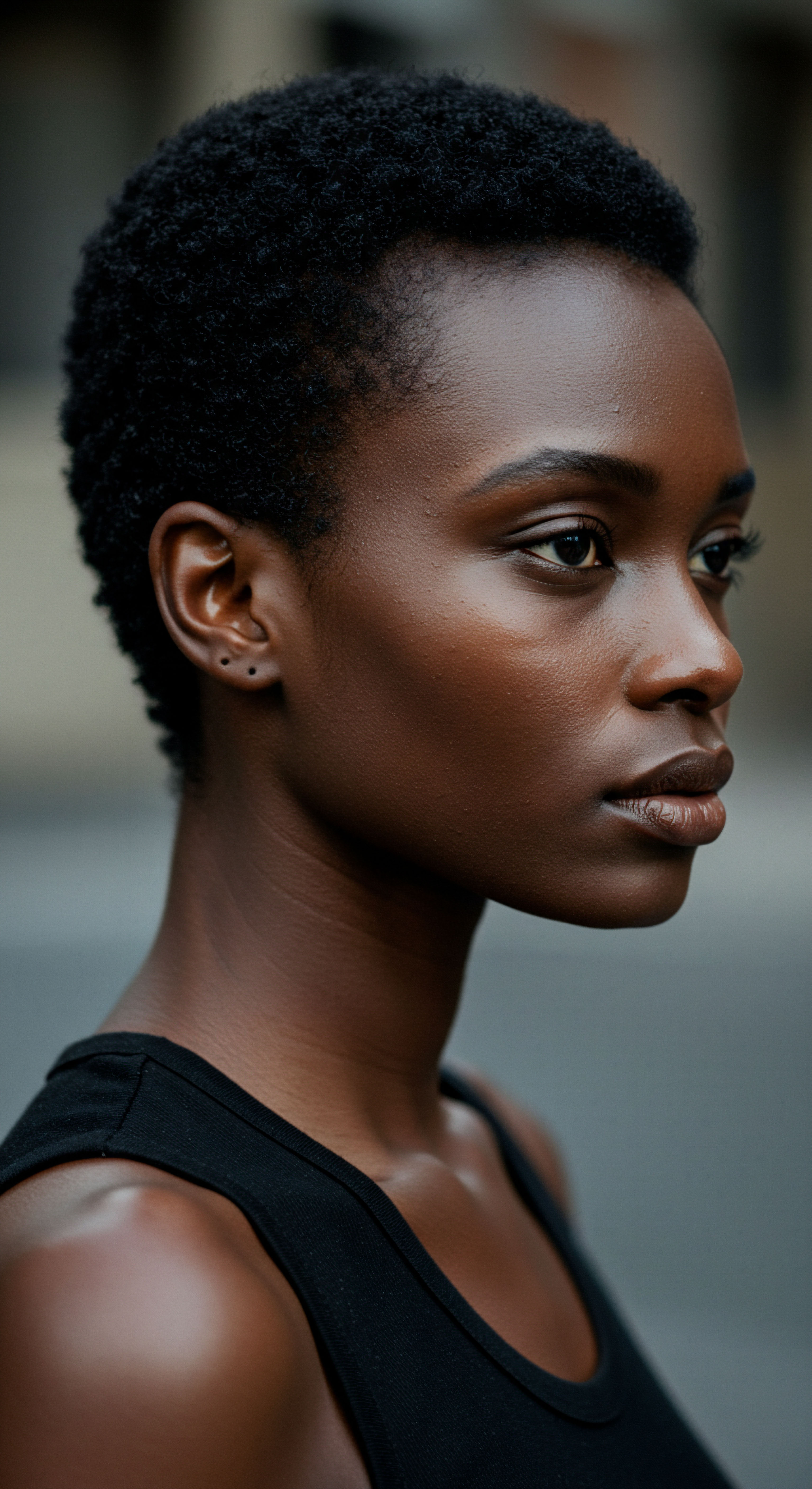
Roots
The very droplets that cleanse can, in their mineral embrace, subtly alter the delicate balance of moisture within each strand of textured hair, leading to an unexpected brittleness. For those with coils, kinks, and waves, this quiet transformation, often unnoticed at first, presents a unique challenge to the hair’s inherent softness and resilience. It is a whisper of the unseen, a story held within the water itself, affecting the very essence of how our hair drinks in life-giving hydration. This foundational understanding begins with recognizing the silent, mineral-laden companions in our daily rinse.

The Water’s Unseen Passengers
Water, a fundamental element of existence, rarely arrives in its purest form to our showerheads. Instead, it carries dissolved geological remnants, remnants of its long journey through subterranean layers. These dissolved solids, particularly certain mineral ions, define what we term “hard water.” Their presence is not merely an academic point; it sculpts the daily reality of hair care for countless individuals, especially those whose hair structures naturally crave and rely upon unhindered moisture.
The primary culprits in hard water’s interaction with hair are often Calcium and Magnesium. These bivalent cations, meaning they carry a double positive charge, possess a particular affinity for the negatively charged proteins that compose the hair shaft. Think of it as a subtle magnetic pull, where these minerals are drawn to and bind upon the hair’s surface. This adherence forms a film, a mineral veil, that while microscopic, casts a long shadow over the hair’s ability to absorb and retain moisture.

Decoding Hard Water’s Mineral Content
Beyond calcium and magnesium, other minerals can contribute to water hardness and its subsequent impact on hair. These include Iron, Copper, and sometimes trace amounts of Silica, Zinc, or Aluminum. Each of these brings its own set of challenges.
Iron, for instance, can lead to reddish or orange discoloration on lighter hair and contribute to dryness, while copper might impart a greenish tint. The cumulative effect of these various ions creates a complex barrier that textured hair, with its unique structural characteristics, finds particularly challenging to overcome.
Hard water’s mineral ions, primarily calcium and magnesium, form a subtle, unseen film on hair strands, hindering moisture absorption.
The distinction in how these minerals affect textured hair compared to straighter hair lies in the very architecture of the strand. Textured hair, by its very nature, often possesses a more open cuticle structure, particularly at the bends and turns of its coil pattern. This inherent characteristic, while allowing for vibrant volume and unique styling, also presents more surface area and potential entry points for mineral deposition. Consequently, the mineral film forms more readily and often more stubbornly, exacerbating the challenge of hydration.

The Hair Strand’s Outer Layer
To truly grasp the influence of hard water, one must consider the hair’s outermost protective layer ❉ the cuticle. Imagine the cuticle as a shingled roof, with individual scales overlapping to shield the inner cortex. In healthy, moisturized hair, these scales lie flat and smooth, allowing light to reflect and enabling efficient moisture exchange. When hard water minerals accumulate, they disrupt this orderly arrangement.
They can lift the cuticle scales, making the hair feel rough and less pliable. This physical interference is the first step in the cascade of issues leading to diminished moisture absorption.
Furthermore, the pH of hard water typically leans towards the alkaline side. Hair, on the other hand, thrives in a slightly acidic environment, usually around a pH of 4.5 to 5.5. Exposure to alkaline water causes the cuticle scales to swell and open even further. This opening, combined with the mineral deposits themselves, creates a formidable barrier.
Conditioners, emollients, and even plain water struggle to penetrate this mineralized, lifted cuticle, leaving the hair feeling dry, brittle, and unresponsive to conditioning efforts. The hair, in essence, becomes thirsty despite being regularly washed.
The impact is not merely superficial. Over time, the continuous deposition of minerals can lead to a phenomenon known as Mineral Crusting. This crust can weigh the hair down, strip its natural luster, and make it feel stiff.
For textured hair, which relies on its natural elasticity and movement, this stiffness can translate directly into increased breakage during detangling or styling. The seemingly innocuous act of washing can, over time, subtly undermine the hair’s structural integrity, making the quest for moisture an ongoing battle.

Mineral Deposition on Textured Hair
The unique helical structure of textured hair means that mineral deposits can accumulate not only on the surface but also within the nooks and crannies of the coil. This makes removal more challenging and the impact on moisture absorption more pronounced. The mineral film effectively coats the hair, creating a physical barrier that prevents water molecules from adequately reaching the hair’s cortex, where moisture is held. This results in a perpetual state of dryness, even when hydrating products are applied.
| Mineral Type Calcium |
| Primary Hair Effect Forms a white film, stiffens hair, reduces shine. |
| Impact on Textured Hair Increased brittleness, difficulty detangling, barrier to moisture. |
| Mineral Type Magnesium |
| Primary Hair Effect Similar to calcium, contributes to dryness and dullness. |
| Impact on Textured Hair Compounded dryness, diminished softness, rough texture. |
| Mineral Type Iron |
| Primary Hair Effect Orange/red tint, dry, rough feel. |
| Impact on Textured Hair Can deepen natural dark tones or cause unwanted discoloration, severe dryness. |
| Mineral Type Copper |
| Primary Hair Effect Greenish tint, particularly on light or chemically treated hair. |
| Impact on Textured Hair Alters hair color, contributes to dryness and weakened strands. |
| Mineral Type Silica |
| Primary Hair Effect Can cause gritty feel, build-up. |
| Impact on Textured Hair Adds weight, reduces hair's natural bounce and definition. |

Ritual
Stepping into the realm of daily care, we acknowledge the profound influence of our practices on the hair’s vitality. The wisdom gathered from understanding hard water’s subtle interference now guides us toward intentional rituals, towards methods that honor the hair’s thirst for hydration. It is in these deliberate actions, in the careful selection of tools and products, that we begin to reclaim the hair’s inherent softness and its ability to truly drink in moisture. This journey is not about rigid rules, but about gentle, informed guidance.

Cleansing with Purpose
The first line of defense against hard water’s mineral assault lies in the cleansing ritual itself. A conventional shampoo, designed primarily for dirt and oil removal, may not possess the specific capabilities required to dislodge mineral deposits. This is where Chelating Shampoos step onto the stage.
These specialized formulations contain ingredients that act like tiny, invisible magnets, binding to the mineral ions and allowing them to be rinsed away with water. Common chelating agents include disodium EDTA, tetrasodium EDTA, sodium phytate, and citric acid.
The efficacy of a chelating shampoo hinges on its ability to effectively sequester these metallic ions. Regular use, perhaps once every two to four weeks depending on water hardness and individual hair needs, can significantly reduce mineral build-up. For textured hair, this practice is particularly beneficial as it clears the path for subsequent conditioning treatments to truly perform their function. Without this preparatory step, even the richest conditioners may merely sit atop the mineral-coated strands, offering superficial comfort rather than deep nourishment.

How Chelating Agents Work
Chelation, derived from the Greek word ‘chele’ meaning claw, describes the process where a chemical compound forms a stable, water-soluble complex with metal ions. These complexes prevent the mineral ions from reacting with other substances, including hair proteins, and allow them to be washed away. This process is distinct from mere cleansing; it is a targeted intervention designed to specifically address the mineral barrier.
The frequency of chelating shampoo use should be carefully considered. While powerful, overuse can sometimes be drying for certain hair types. Observing how your hair responds is key. Signs that a chelating wash is needed might include hair feeling rough, stiff, dull, or unusually resistant to styling products and moisture.
A study published in the Journal of Cosmetic Science, for instance, demonstrated that hair washed with hard water showed increased mineral deposition and reduced tensile strength compared to hair washed with soft water, highlighting the physical impact of these minerals on hair integrity. This underscores the tangible benefit of proactive mineral removal.
Intentional cleansing with chelating shampoos dislodges hard water minerals, clearing the path for true moisture absorption in textured hair.

The Role of Acidic Rinses
Following a chelating wash, or even as a standalone practice for mild hard water concerns, Acidic Rinses offer a gentle yet effective solution. The most commonly employed is a diluted apple cider vinegar (ACV) rinse. As previously noted, hard water is often alkaline, causing the hair cuticle to lift.
An acidic rinse helps to rebalance the hair’s pH, encouraging the cuticle scales to lie flat once more. When the cuticle is smoothed, it not only reflects light better, contributing to shine, but also seals in moisture more effectively.
The benefits extend beyond pH balancing. The acetic acid in ACV also possesses mild chelating properties, helping to dissolve some mineral deposits and product build-up. This dual action contributes to a cleaner, smoother hair surface, making it more receptive to subsequent conditioning. For textured hair, where smoothness and reduced friction are paramount for preventing tangles and breakage, an acidic rinse can be a truly transformative step in the ritual.

Crafting an Acidic Rinse
A typical ACV rinse involves diluting one part apple cider vinegar with three to five parts water. This mixture can be applied after shampooing, left on for a few minutes, and then rinsed thoroughly. The key is dilution; undiluted ACV is too acidic and can be detrimental.
Other acidic rinses might include diluted lemon juice, though ACV is generally preferred for its milder nature and additional beneficial compounds. The consistency of this ritual helps to maintain the hair’s natural pH equilibrium, a crucial aspect of its overall health and moisture retention capabilities.
- Assess Your Water Hardness ❉ Begin by understanding the mineral content of your local water supply, as this dictates the frequency and intensity of your hard water hair care ritual.
- Incorporate Chelating Washes ❉ Integrate a chelating shampoo into your regimen, perhaps bi-weekly or monthly, to actively remove accumulated mineral deposits from your hair strands.
- Utilize Acidic Rinses ❉ Follow up with a diluted apple cider vinegar rinse to help rebalance your hair’s pH, smooth the cuticle, and enhance moisture retention.
- Deep Condition Regularly ❉ After mineral removal, consistently apply deep conditioning treatments to ensure your hair fully absorbs the much-needed hydration.
- Consider Shower Filtration ❉ Explore installing a shower filter as a proactive measure to reduce mineral exposure at the source, offering a continuous defense against hard water effects.

The Power of Deep Conditioning
Once the mineral barrier has been addressed, the hair is finally prepared to receive and absorb moisture effectively. This is where Deep Conditioning Treatments truly shine. These formulations are richer and more concentrated than daily conditioners, designed to penetrate deeper into the hair shaft and deliver intense hydration, emollients, and strengthening proteins. For textured hair, which often has a natural propensity for dryness, deep conditioning is not a luxury but a fundamental component of a healthy hair ritual.
The efficacy of a deep conditioner applied to mineral-laden hair is significantly diminished. The mineral film acts as a literal shield, preventing the beneficial ingredients from reaching the hair’s inner structures. However, once chelating shampoos or acidic rinses have cleared this pathway, the hair becomes highly receptive. This allows the humectants, oils, and proteins in the deep conditioner to perform their intended function ❉ drawing moisture into the hair, sealing it within, and repairing any damage.

Optimizing Deep Conditioning for Textured Hair
For optimal results, deep conditioners should be applied to clean, damp hair and left on for an extended period, often 20-30 minutes, sometimes with the aid of gentle heat (such as a hooded dryer or a warm towel wrap) to further enhance penetration. The choice of deep conditioner should align with the hair’s specific needs – whether it requires protein for strength, intense moisture for dryness, or a balance of both. The ritual of deep conditioning, performed consistently after addressing mineral build-up, ensures that textured hair remains soft, pliable, and truly moisturized, countering the dehydrating effects of hard water.

Relay
Our understanding now deepens, moving beyond the immediate surface to the intricate interplay of factors that shape our hair’s response to its environment. This exploration invites us to consider the nuanced conversation between science, heritage, and the broader context of hair wellness. How do these seemingly disparate elements converge to inform our approach to hard water’s silent challenge, particularly for textured hair? It is a dialogue that calls for a profound insight, one that bridges the empirical with the experiential, offering a more complete picture of hair’s resilience and vulnerability.

The Science of Ionic Interaction
At a molecular level, the effect of hard water minerals on textured hair’s moisture absorption is a compelling study in ionic interactions. Hair proteins, particularly keratin, possess numerous anionic (negatively charged) sites along their structure. These sites are the primary targets for the cationic (positively charged) mineral ions like calcium (Ca²⁺) and magnesium (Mg²⁺).
When these bivalent ions bind to the hair, they neutralize the negative charges, disrupting the hair’s natural electrostatic balance. This disruption can affect the hair’s ability to bind with water molecules, which are polar and interact with charged surfaces.
Beyond simply coating the hair, mineral ions can also interact with surfactants in shampoos, forming insoluble precipitates. This is the familiar “soap scum” often seen in hard water areas. When this precipitate forms on hair, it further exacerbates the problem, adding another layer of physical barrier that repels water and prevents conditioning agents from performing their function. The result is hair that feels not only dry but also coated and heavy, despite being freshly washed.

Hair’s Hydrophobic Shift
The accumulation of these mineral deposits can alter the hair’s surface from a relatively hydrophilic (water-loving) state to a more hydrophobic (water-repelling) one. This shift is a direct consequence of the mineral film creating a less permeable surface. Imagine a sponge that has been coated in a thin layer of wax; it struggles to absorb water.
Similarly, textured hair, which already possesses a complex cuticle structure that can sometimes hinder uniform moisture distribution, becomes even more resistant to hydration when burdened by mineral deposits. This diminished capacity for water uptake is a critical factor in the persistent dryness experienced by many with textured hair in hard water regions.
Hard water minerals create a hydrophobic barrier on hair, altering its surface and severely impeding moisture absorption.
Research has consistently shown the detrimental effects of mineral accumulation. A study published in the International Journal of Trichology investigated the mineral content of hair and its correlation with hair damage. The findings indicated that hair samples from individuals in hard water regions exhibited significantly higher levels of calcium and magnesium, which corresponded with increased hair breakage and reduced elasticity. This scientific corroboration reinforces the lived experiences of individuals grappling with hard water’s effects on their textured strands.

Cultural Wisdom and Hair Preservation
The challenges posed by water quality are not new; they have been navigated by communities for centuries. Across various cultures with rich traditions of textured hair care, ingenious methods were developed to address environmental factors, including water sources. While not always framed in modern scientific terms of “chelating” or “pH balancing,” many traditional practices intuitively countered the effects of hard water.
For instance, the use of rainwater for hair washing was a common practice in many African and diasporic communities. Rainwater, being naturally soft and free of dissolved minerals, provided a gentle cleansing medium that allowed hair to retain its softness and moisture. Similarly, various plant-based rinses, often acidic in nature, were historically employed.
Ingredients like hibiscus, tamarind, or even certain fermented liquids, when used as hair rinses, would have contributed to pH balancing and potentially aided in the removal of mineral residues, albeit unknowingly from a scientific perspective. These practices underscore a deep, ancestral understanding of hair’s needs in diverse environments.

Generational Hair Care Practices
The wisdom passed down through generations often contained practical solutions for environmental challenges. Recipes for hair masks utilizing ingredients rich in natural acids, or the practice of collecting and storing rainwater for hair days, speak to a collective knowledge of how to preserve hair health. These traditions were not merely aesthetic; they were often rooted in the pragmatic need to maintain hair integrity and manageability, especially in contexts where water sources were varied and sometimes challenging.
| Hair Property Moisture Absorption |
| Hard Water Effect Reduced due to mineral barrier |
| Consequence for Textured Hair Chronic dryness, increased brittleness, dull appearance |
| Hair Property Tensile Strength |
| Hard Water Effect Decreased due to mineral binding |
| Consequence for Textured Hair Higher susceptibility to breakage during styling and detangling |
| Hair Property Cuticle Smoothness |
| Hard Water Effect Disrupted by mineral deposits and high pH |
| Consequence for Textured Hair Rough texture, increased friction, tangles, reduced shine |
| Hair Property Elasticity |
| Hard Water Effect Compromised, leading to stiffness |
| Consequence for Textured Hair Loss of natural bounce, hair feels less pliable and responsive |
| Hair Property Color Vibrancy |
| Hard Water Effect Can be altered or dulled by mineral interactions |
| Consequence for Textured Hair Discoloration, especially with iron/copper, reduced richness of natural or dyed color |
| Hair Property Hard water significantly compromises the structural integrity and aesthetic qualities of textured hair. |
The ongoing conversation about hair porosity also gains a new dimension when considering hard water. While hair porosity is largely genetically determined, the effects of hard water can mimic or exacerbate the challenges associated with certain porosity types. For instance, low porosity hair, which naturally resists moisture penetration, becomes even more impenetrable when coated with minerals.
Conversely, high porosity hair, which absorbs moisture quickly but struggles to retain it, finds its cuticle further compromised by alkaline hard water, leading to even faster moisture loss. Understanding this interaction allows for more targeted and effective hair care strategies.

Reflection
The journey through the subtle yet significant effects of hard water on textured hair reveals a deeper understanding of hair’s intricate relationship with its environment. It highlights the quiet resilience of our strands and the profound impact of intentional care. Each coil, each wave, holds a story of adaptation, and in understanding the unseen elements within our water, we gain the power to truly nourish and celebrate its unique beauty. This is not merely about addressing a problem; it is about cultivating a deeper connection with our hair, honoring its heritage, and empowering its inherent vitality.

References
- Robbins, C. R. (2012). Chemical and Physical Behavior of Human Hair (5th ed.). Springer.
- Draelos, Z. D. (2011). Hair Cosmetics ❉ An Overview. Clinical Dermatology, 29(3), 268-272.
- Ghasemi, M. Javanmardi, H. & Mohammadi, M. (2018). Evaluation of the effect of hard water on hair tensile strength and mineral content. International Journal of Trichology, 10(6), 269-272.
- Dawber, R. P. R. & Van Neste, D. (2002). Hair and Scalp Disorders ❉ Common Problems and Their Management. Blackwell Science.
- Poucher, W. A. (1993). Poucher’s Perfumes, Cosmetics and Soaps (9th ed. Vol. 3 ❉ Cosmetics). Chapman & Hall.